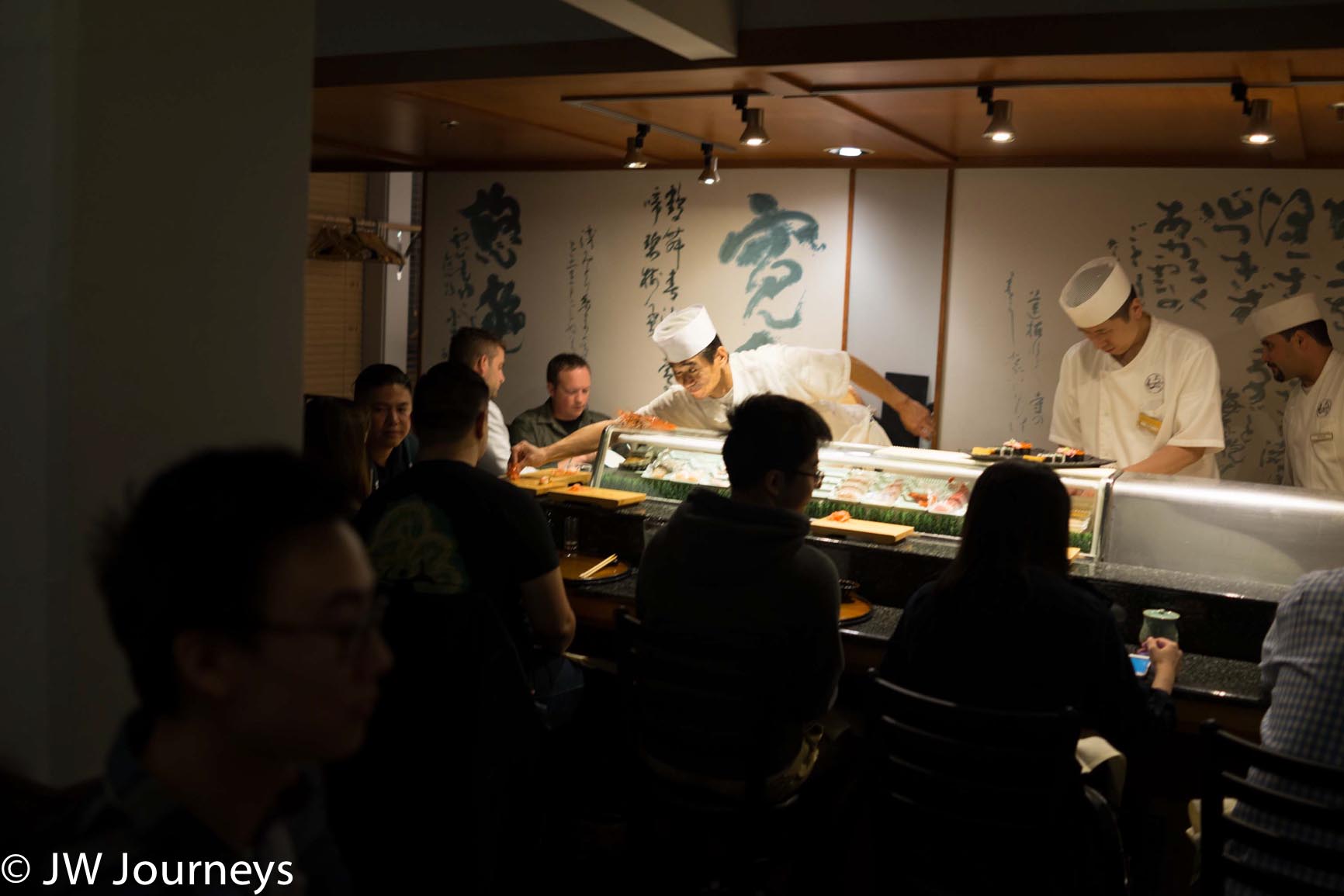Shiro's sushi - Jiro dreams of sushi apprentice in Seattle
Shiro sushi
In Jiro dreams of sushi, the apprentice that made tamago for 10 years before getting the final approval was at the Seattle establishment of Shiro’s. Shiro’s is located in Belltown and within walking distance from downtown. The founder Shiro Kashiba was also an apprentice of Jiro ono san. Reservations are highly recommended. Bar seats are not available to reserve and comes at a first come first serve basis. Bar seats allows you to do omakase a different way, you tell chef what you want and tell them when to stop. At the bar seats, you get to see how the sushi chefs work behind the counter.
Shiro sushi bar area
Sushi is 90% preparation, 10% show and you get to see how the 10% show happens at the bar.
Shiro sushi chef in action
I usually go for the Premium sushi omakase which comes with 18 pieces of sushi, served in five sushi courses and one hot dish.
Shiro sushi menu
To start off, a seaweed dish in sweet vinegar, similar to sunomono.
Shiro sushi seaweed salad
First course - milder salt water fish
You start from the right and eat towards the left as the layers of flavor gets more intense as you eat towards the left. The very left is sea bass and it is topped with plum sauce. The server mentions to you that all the nigiri pieces are already seasoned to chef’s standards and the dipping of extra soy sauce is not recommended.
Shiro sushi first course
I also ordered a bowl of miso soup. The seaweed is fine nori, not kelp.
Shiro sushi miso soup with nori
Second course - Salmon
Starting from the right, it’s normal salmon. There is very high fat content from the salmon so it is either from Norway ( due to colder climate, fish need to fatten up ) or king salmon from the pacific northwest. I did not get to ask where this salmon was from. The middle nigiri was my favourite, salmon wrapped in vinegar pickled onion. The tartness from the onion pickle balances the fat from the salmon perfectly. The very left is salmon belly ( salmon toro). Very very rich.
Shiro sushi salmon course
Third course - Eel and scallops
The waiter also brought a bowl of nigiri shoyu- Nikiri ( sushi soy sauce) Nigiri shoyu is made from soy sauce boiled down with mirin for sweetness and some stores use dried bonito flakes for extra umami kick. After the soy sauce is boiled down, the alcohol from the mirin evaporates and the nigiri shoyu is chilled and ready to serve. Only this course used the Nikiri when serving.
Shiro sushi third course scallop, eel and prawn
Starting from the right is the conch, then local geoduck. At the time is november and the water is starting to become colder, the geoduck is extremely sweet, succulent with crispy texture. Delicious. Then comes the saltwater eel. The common eel that is used in sushi restaurants are farmed freshwater eel. The saltwater eel (Anago) is sweeter and softer. Paired with the sweet Nikiri, wonderful.
Shiro sushi nigiri with nikiri( sweet nigiri soy sauce)
The last is the local and in season spot prawn. The pacific northwest has a lot of spot prawns and it is very sweet and bouncy. Shiro's imports spot prawns from the icy waters of Northern BC. The only quality bar is the translucency of the prawn. The more transparent, the fresher the prawn. The heard is also fried and can be eaten whole, served with a lemon wedge to cut the grease. The tempura is executed beautifully. I am sure the chef used an ice cold batter with very low gluten flour/ cornstarch. The shrimp head was extremely crispy and the the brain in the prawn head was still oozing out. Well done tempura chef.
Shiro sushi - spot prawn on display at the bar before preparation
Shiro sushi fried prawn head
Next up is a pause and the hot dish
This time is a very mild fish broth with a house made fishball. The fish ball is first fried to give it the crispy skin, look at the knife skills of the chef with the hair like spring onions.
Shiro sushi hot dish
When i visited in September, the chefs drove and picked fresh Matsutake mushrooms from the Oregon border and served it in a fish broth in a japanese iron kettle and tea cup. The pine aroma from the mushroom is very strong and very well executed. Matsutake mushrooms loses some of the flavor once the head opens, you can taste the care chef has for the mushrooms as these are all closed but smaller matsutakes, resulting in a stronger pine aroma.
The hot dish depends on the season that you visit Shiro’s.
Fourth course - Here comes the highlight - Tuna
Based on the server, the tuna served tonight was carved two days ago at the sushi counter in the morning. Auctioned from Sardinia, Italy, this was a bluefin tuna clocking in at 230 pounds, considered to be a smaller tuna. The biggest fish sold was around 500 pounds and sold to the sushi chain owner that operates in Park Hyatt, Tokyo for $1.8 M USD. Wow, $1.8 M USD. Would love to see the cutting of the bluefin at Shiro’s
Shiro sushi tuna course
Starting from the right, maguro. The strong red color means this is a very lean piece of tuna. Then comes chutoro, my favorite.
Shiro sushi chutoro in middle
Chutoro means it’s roughly half fat and half lean meat. The balance of the nigiri is striking and it melts in your mouth. Then comes the pickled tuna with grated ginger at the top. It is picked in a soy sauce and vinegar mixture with a bit of acidity. The ginger on top also acts as a palate cleanser to prepare you for the highlight, the otoro. The marbling makes it look almost like a beautiful piece of beef. The otoro just melts, it’s like butter with tuna explosion. Although the otoro is beyond this world, i prefer the chutoro more as it is better balanced.
Shiro sushi otoro
Fifth course - Creamy course
Now comes the creamy way to end the meal. There is the ikura salmon eggs, i did not like this one as the salmon smell was too strong. A better way would be to add more mirin to rid the salmon smell. It is still well executed, but I expected better. The negitoro salmon belly with spring onions is very nice and creamy. Then the last two pieces of seaweed wrapped nigiri are toro and japanese pickles.
Shiro sushi fifth course
Then you finish off with the piece of tamago which is sweet and kind of tough.
Extras
Uni - You can also order the creamy sea urchin. Best time to eat will be in the winter months when the water is colder and they become creamier and fatter. California is the largest Uni producer in North America and Shiro's imports it right from California. There are only 5 lobes of flesh per sea urchin.
Shiro sushi uni sea urchin
More chutoro - Could not get enough of the chutoro
Shiro sushi chutoro
Shiro’s hand roll- I thought it was just okay
Shiro sushi hand cone
Miso grilled black cod - Executed well, the fish flakes off and is buttery
Shiro sushi miso black cod
https://shiros.com/, Comparison of Shiro’s sushi and Sushi Kashiba’s down the street
Story of Shiro Kashiba san, the original owner who is also an apprentice of Jiro ono. Now he’s onto the next restaurant Kashiba's. Although good as well, i prefer the way layers of taste are built onto each other at Shiro’s.
Tips:
Premium sushi omakase is worth the money because of the layering of flavors and the curated experience
ordering separately will run you more money but you get what you want
the bar seats where you keep going until you tell the chef to stop cannot be reserved, come early around 5pm if you want a bar seat and see the chefs at work





















